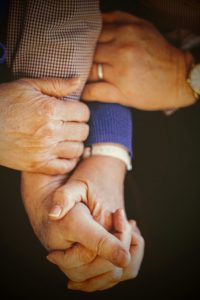
Let us unpack Empathy to shed a practical, realistic – interpretation of this all-important word:
E stands for eye contact. Eye contact is usually the first indication that we’ve been noticed by someone, even though cultural norms can vary.
M stands for muscles of facial expression. The human face is the one part of us that we almost never fully cover up. Our faces are a roadmap of human emotion, and because of this, our facial expressions cannot not only save our lives, but can preserve our species.
P stands for posture. Posture is another powerful conveyor of connection. Our open or closed posture signal powerful approach and avoidance signals to others. In one study, doctors who were told to sit down on rounds were rated as much warmer, more caring, and estimated to have spent three to five times longer with their patients than doctors who stood up but used the exact same words.
A stand for affect. We are trained to label our patient’s affect as a way of orienting ourselves to the emotional experience of the person. Affect is the scientific term for expressed emotions. When you’re with someone, try just sort of labeling, you know, is Albert upset? Is Peter excited? is James upset? And it’ll change how you hear what they’re saying.
T stands for tone of voice. We have all heard the crack in someone’s voice who is about to cry. We’ve also heard the edge in someone’s voice who’s about to get angry.
H stands for hearing the whole person far more than the words that people say. Hearing the whole person means understanding the context in which other people live.
Y stands for your response. We respond to other people’s feelings all the time. We might think that we only experience our own emotions, but we’re constantly absorbing the feelings of others. It turns out that a helpful guide is that most feelings are mutual.

Studies from neuron science journals suggests that we have systems of mirror neurons in our brains that cause us to mimic the actions of others. That is why when we see someone yawn, we will often yawn and reply. And when we observe someone experiencing joy or pain, we experience the same sensation to a certain extent. But these reactions are primarily driven by subconscious reflexes. To be truly empathic, you have to actively think beyond yourself and your own concerns. You can develop this empathic skill by practicing some simple habits. Be observant of others. We tend to spend the majority of our day dwelling on ourselves, caught up in our own daily routines and digital distractions. But taking the time to observe others around you is a good first step in developing your empathy. Watch and wonder. Try to focus on the person’s state of being rather than categorizing or labeling them.
Ask yourself, what kind of day are they having? How are they feeling? Challenge yourself to genuinely care about their wellbeing. Curiosity about others is the first step to expanding your empathy. Use active listening during a conversation, especially a heated one. Most people formulate the response before the other person even finishes their statement. This form of communication is more verbal combat than an exchange of ideas or opinions. Avoid this reflex by slowing down rather than rushing to reply. Take a moment to consider the other person’s statement. Ask to follow up questions to better understand what the speaker intended. Try to understand their emotional state and the deeper motivations behind their statement. What life experiences led them to their current worldview. Remember, you don’t need to share someone’s opinion in order to understand it and acknowledge it, and listening will help inform and expand your own opinion.
We all live in our own version of reality, A reality that is limited by our senses, our temperament, and our own experiences. It is the only reality we will ever truly know, but it is crucial to our personal development, our relationships, and to society itself, that we make the effort to try and experience other people’s realities as well. This is done through empathy. Simply stated, empathy is an active attempt to understand another person’s perspective, their emotions, and in essence their reality. We are social animals and our ability to communicate and understand each other’s emotional states is key to maintaining our relationships. So it is little wonder that the ability to empathize is hardwired directly into our brains. One area that assists in this process is the right super marginal gyrus, which helps us to distinguish our own emotional state from that of another person and plays a key role in our ability to observe and assess what other people are experiencing.
Learning more about other people’s experiences is a key element to seeing the world do someone else’s eyes. But it is also important to open up about your own feelings and experiences. Empathy is a two-way street that, at best is built upon mutual understanding. Through a combination of uncovering the deeper motivations of someone else’s position and expressing our own underlying concerns. We often discover a shared commonality even with those who hold different beliefs than ours through the practice of keeping an open mind. Empathy helps us challenge prejudice, find commonality, and expand our moral universe. Without it, we are apt to label people outside our circle as the other, the problem or the enemy. These labels draw lines in the sand that prevent us from moving forward or growing. It cuts us off from the realization that the human experience is a shared experience. We have much more in common than we think and are really just seeing small variations of the same reality.


